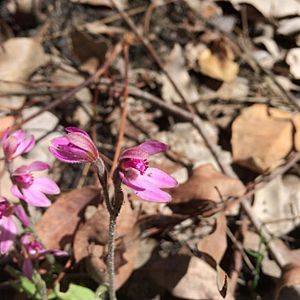Little pink fan orchid facts for kids
Quick facts for kids Little pink fan orchid |
|
|---|---|
 |
|
| Caladenia nana subsp. nana growing near Donnybrook | |
| Scientific classification |
|
| Kingdom: | Plantae |
| Clade: | Tracheophytes |
| Clade: | Angiosperms |
| Clade: | Monocots |
| Order: | Asparagales |
| Family: | Orchidaceae |
| Subfamily: | Orchidoideae |
| Tribe: | Diurideae |
| Genus: | Caladenia |
| Species: |
C. nana
|
| Subspecies: |
C. n. subsp. nana
|
| Trinomial name | |
| Caladenia nana subsp. nana |
|
| Synonyms | |
|
Caladeniastrum nanum (Endl.) Szlach. |
|
The little pink fan orchid (scientific name: Caladenia nana subsp. nana) is a beautiful plant. It belongs to the orchid family. You can only find this special orchid in the south-west part of Western Australia. It's a small orchid. It has one hairy leaf and usually up to three pink flowers. These flowers have short, fan-like parts called sepals and petals. This orchid often grows in groups, making dense clumps.
What it Looks Like
The little pink fan orchid is a plant that grows on the ground. It is a perennial plant, meaning it lives for more than two years. It's also a deciduous plant, so it loses its leaves at certain times. This orchid has a special underground part called a tuber. It's like a small, round storage organ.
These orchids often grow in groups. You might see up to twenty plants growing close together. Each plant has one straight, hairy leaf. This leaf is about 50 to 90 millimeters (2 to 3.5 inches) long. It is also about 3 to 10 millimeters (0.1 to 0.4 inches) wide.
The flowers are usually pale to deep pink. Sometimes, they can even be white. There are usually up to three flowers on a stem. This stem grows about 50 to 150 millimeters (2 to 6 inches) tall. Each flower is about 10 to 30 millimeters (0.4 to 1.2 inches) long and wide.
The top part of the flower, called the dorsal sepal, curves forward. It goes over the central part of the flower, which is called the column. The other sepals and the petals are short and spread out. They look a bit like a fan. The side sepals are joined together at their bases.
The orchid also has a special lip-like part called the labellum. This part is narrow. It has small, blunt teeth along its sides. There are also two rows of small bumps, called calli, along its middle. The little pink fan orchid blooms from late September to October.
Naming the Orchid
The scientific name for this orchid is Caladenia nana subsp. nana. A scientist named Stephan Endlicher first described this plant in 1846. He found a sample of it near Wilson Inlet. The description was then published in a book called Plantae Preissianae.
Later, in 2001, two other scientists, Stephen Hopper and Andrew Brown, made a change. They decided that another orchid, Caladenia unita, was actually a type of Caladenia nana. So, the orchid we are talking about became known as subspecies nana.
The word nana in the orchid's name comes from Latin. It means "dwarflike" or "small." This name fits because it is a relatively small orchid.
Where it Lives
You can find the little pink fan orchid in the south-west of Western Australia. It grows in areas between the cities of Perth and Bremer Bay. It lives in different types of places, like forests and woodlands.
This orchid usually needs a special event to flower well. It rarely blooms unless there has been a bushfire in the area during the previous summer. The fire helps clear the ground and allows the orchid to grow and flower.
Protecting the Orchid
The Western Australian Government's Department of Parks and Wildlife keeps track of plants and animals. They have classified Caladenia nana subsp. nana as "not threatened." This means that, for now, there are enough of these orchids, and they are not in danger of disappearing.

